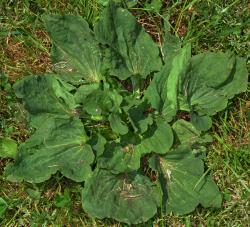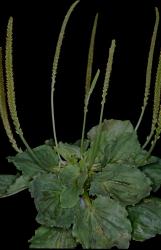- Taxon
- Gallery
Hairy or occasionally glabrous short-lived perennial herb with stout caudex and many large adventitious roots, occasionally with persistent, well-developed primary roots. Lvs all radical, rosulate; petiole 1–20–(30) cm long, broadened at base, channelled. Lamina to 21 × 16 cm, ovate to suborbicular (somewhat narrower in small-leaved plants), generally puberulent, at least on the main veins beneath, sometimes glabrate or glabrous, entire or remotely dentate; main veins 5–7; base truncate to cordate in more typical large-leaved plants but often cuneate to attenuate in smaller, and especially narrower-leaved forms; apex rounded to obtuse. Scapes c. 5–80 cm long, not ribbed, generally hairy, at least towards base, sometimes glabrous or nearly so. Spikes dense, 1.5- c. 30 cm long, narrow-cylindric. Bracts ovate, > calyx, herbaceous and keeled, glabrous, sometimes with membranous margin. Sepals 1.5–2.1 mm long, broad-ovate; keel green and herbaceous, otherwise sepal scarious. Corolla tube = or slightly < calyx; lobes 1–1.3 mm long, ovate to elliptic-ovate, reflexing. Stamens glabrous, long-exserted. Style long-exserted, puberulent. Capsule usually 2.5–4 mm long, broad-ellipsoid, 6–16-seeded. Seeds 1–1.8 mm long, slightly trigonous but also rather irregular, rugose, dark red, brown, dark brown or black.
[From: Webb et al. (1988) Flora of New Zealand. Volume 4.]
Flowering: Jul.–Apr.





